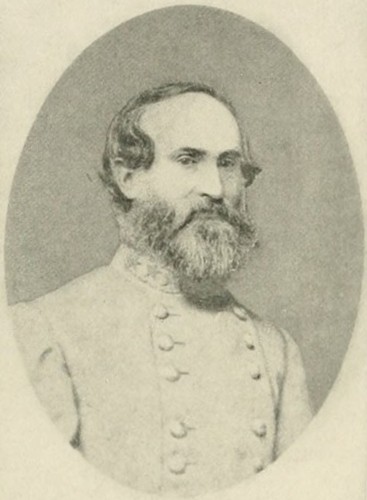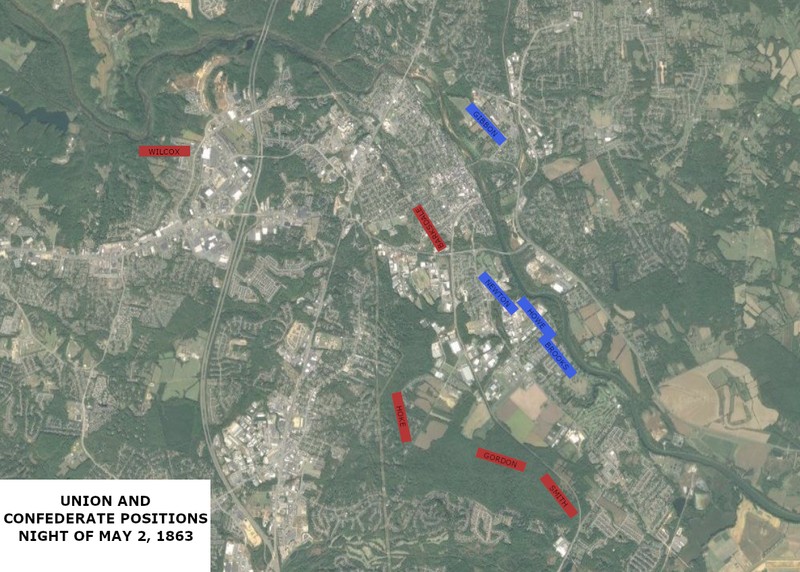Jubal Early's Position, May 1-2
Introduction
Text-to-speech Audio
Images
Major General Jubal Early

Jubal Early positioned most of his troops to the south of Fredericksburg where he expected a Union attack would be more likely (map by Kathleen Thompson)

Backstory and Context
Text-to-speech Audio
By the night of April 30, with Sedgwick’s troops largely inactive in front of the Fredericksburg lines, General Robert E. Lee realized that the Union force was just a diversion. Recognizing that the main attack must be coming from the rear, Lee shifted first the division of Maj. Gen. Lafayette McLaws and then the troops under Lieut. Gen. Thomas “Stonewall” Jackson to the west. To prevent any advance by Sedwick and keep up the ruse that Lee remained in his trenches, Jackson’s troops did not move until after it was dark. Lee left Major General Jubal Early defending Fredericksburg.
Early had approximately 13,000 men and 46 guns to defend seven miles of entrenchments. For most of May 1 Early’s Confederates and the Federal forces of Sedgwick and Reynolds stayed in place and improved their lines as their commanders awaited word from Lee and Hooker to the west. On May 2 Lee’s chief of staff, Col. Robert H. Chilton, met with Early to convey Lee’s orders. According to Chilton, Early was to leave one brigade with artillery support to protect Fredericksburg and take the rest of his troops to reinforce Lee at Chancellorsville. Early did not understand why Lee would have him abandon the heights at Fredericksburg, but he complied with the orders and formed up his troops for the march west. Early left Brig. Gen. Harry T. Hays’s brigade and Brig. Gen. William Barksdale’s 18th Mississippi to hold Marye’s Heights and engaged in a lot of deceptive measures to hide the fact that he was withdrawing the majority of his force. Early’s maneuverings were successful in making Sedgwick cautious about attacking the Confederate line on May 2.
Late in the afternoon, as “Stonewall” Jackson’s flank attack routed the Union XI Corps to the west, Early marched his division towards Chancellorsville along the Plank Road. Couriers riding from both directions came upon Early around the same time. Orders from Lee stated that he never ordered the evacuation of Fredericksburg and that there had been a miscommunication of orders. News from Fredericksburg indicated that Sedgwick’s men were on the move and were threatening the small Confederate force left to hold the Heights. Early had to quickly turn his men around and hurry back to Fredericksburg. Not knowing the situation and whether the Federal VI Corps had captured the Confederate force at Fredericksburg, Early directed his entire division towards the heights. Fortunately for the Confederates, Sedgwick had been cautious and not attacked the reduced force at the city. Early’s men were able to retake their previous positions during the evening of May 2.
By the morning of May 3, Early’s men held the seven-mile-long front along the heights at and below Fredericksburg. The majority of Early’s force was stationed to the south of the city, near Prospect Hill. Early did not expect the Union to try for a head-on assault of Marye’s Heights after the disaster the previous December. The Union VI Corps (and I Corps before it was shifted to Chancellorsville) had been on the plains below Fredericksburg for several days and Early expected the attack to come at the point where the Union had successfully broken the Confederate line during the previous battle. Early left only about 1,200 men and less than a dozen artillery pieces at Marye’s Heights.
Sources
Furgurson, Ernest B. Chancellorsville, 1863: The Souls of the Brave. New York: Vintage Books, 1992.
Gallagher, Gary W. The Battle of Chancellorsville. National Park Civil War Series. Eastern National, 2007.
Parsons, Philip W. The Union Sixth Army Corps in the Chancellorsville Campaign: A Study of the Engagements of Second Fredericksburg, Salem Church and Banks’s Ford, May 3-4, 1863. Jefferson, NC: McFarland & Company, Inc., 2006.
Sutherland, Daniel E. Fredericksburg and Chancellorsville: The Dare Mark Campaign. Lincoln: University of Nebraska Press, 1998.
"Jubal Early." Wikipedia. Accessed May 4, 2021. https://en.wikipedia.org/wiki/Jubal_Early.
Map by Kathleen Thompson
